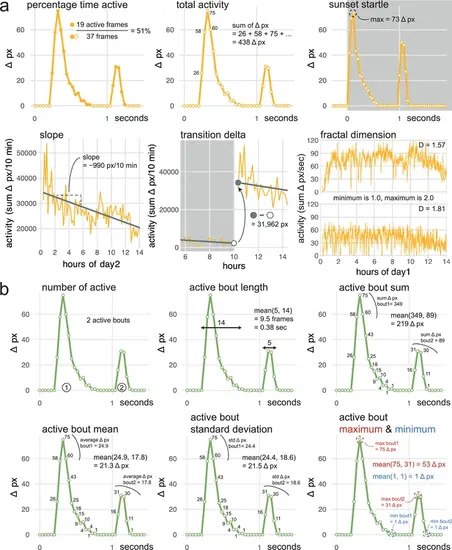Fig. 2 - Supplemental 1
- ID
- ZDB-FIG-250324-4
- Publication
- Kroll et al., 2025 - Behavioural pharmacology predicts disrupted signalling pathways and candidate therapeutics from zebrafish mutants of Alzheimer's disease risk genes
- Other Figures
-
- Fig. 1
- Fig. 1 - Supplemental 1
- Fig. 2
- Fig. 2 - Supplemental 1
- Fig. 2 - Supplemental 2
- Fig. 3
- Fig. 3 - Supplemental 1
- Fig. 3 - Supplemental 2
- Fig. 3 - Supplemental 3
- Fig. 3 - Supplemental 4
- Fig. 4
- Fig. 4 - Supplemental 1
- Fig. 4 - Supplemental 2
- Fig. 4 - Supplemental 3
- Fig. 4 - Supplemental 4
- Fig. 4 - Supplemental 5
- Fig. 5
- Fig. 5 - Supplemental 1
- Fig. 6
- Fig. 6 - Supplemental 1
- Fig. 7
- All Figure Page
- Back to All Figure Page
|
Behavioural parameters calculated by the FramebyFrame R package on the Δ pixel timeseries. (a) Activity parameters calculated by the FramebyFrame R package annotated on sample data from a single larva. These parameters describe the overall activity of each larva during each day or night and are calculated directly on the Δ pixel timeseries. Sunset startle describes the larva’s startle response when lights abruptly switch off at the day-to-night transition, and therefore is only defined for nights. Activity tends to decrease over the course of the day; the slope parameter describes the rate of this decline. Transition delta describes the sudden jump or drop in activity which occurs at the light transitions. Fractal dimension describes the smoothness (D closer to 1.0) or roughness (D closer to 2.0) of the activity trace. (b) Active bout parameters calculated by the FramebyFrame R package annotated on sample data from a single larva. These parameters describe the average swimming bout of each larva during each day or night. |

